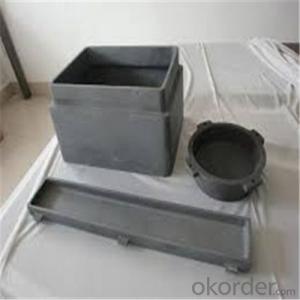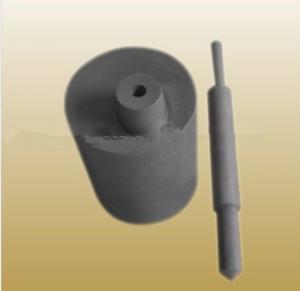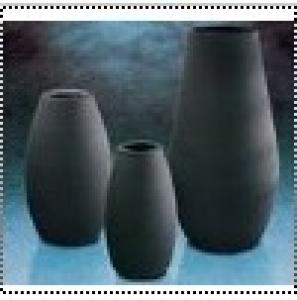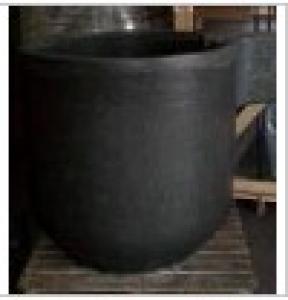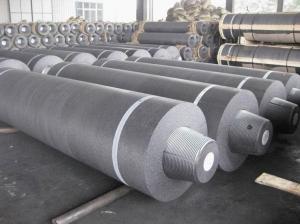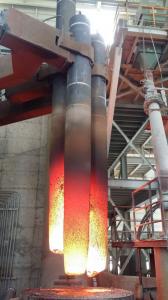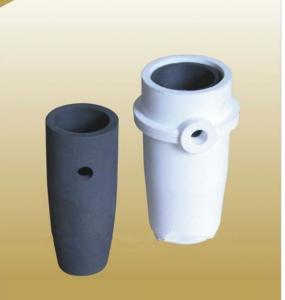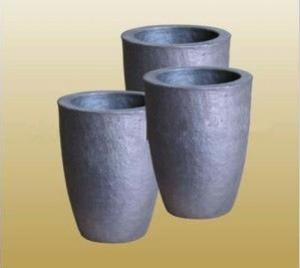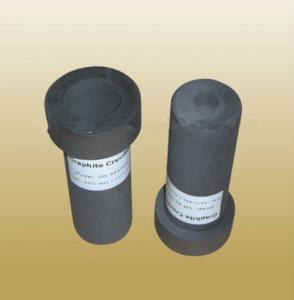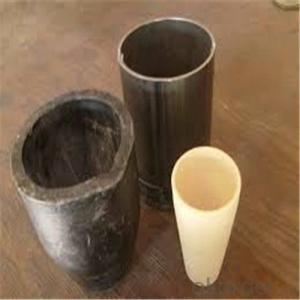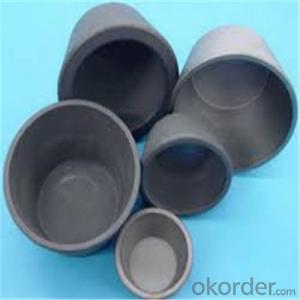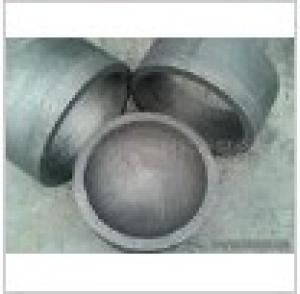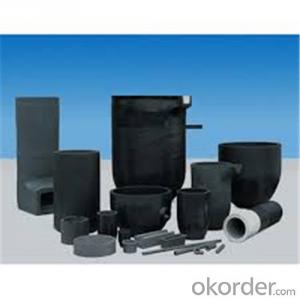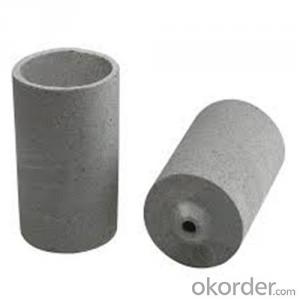Sic Graphite Crucible
- Loading Port:
- Shanghai
- Payment Terms:
- TT OR LC
- Min Order Qty:
- 1 pc
- Supply Capability:
- 1000 pc/month
OKorder Service Pledge
OKorder Financial Service
You Might Also Like
Quick Details
| Application: | melting metals | Height: | depends on your requirement | Top Diameter: | 10-1200mm |
| Bottom Diameter: | 10-1200mm | Place of Origin: | China (Mainland) | Brand Name: | |
| product name: | SiC graphite crucible china graphite crucible | top diameter: | 10-1200mm | bottom diameter: | 10-1200mm |
| height: | depends on your requirement | application: | melting gold,silver and other metals | Specific resistance: | ≤14μΩ.m |
| Bending strength: | ≥25MPa | Compressive strength: | ≥50MPa | Bulk densit: | ≥1.68g/cm3 |
| Ash content: | ≤0.15% |
Packaging & Delivery
| Packaging Details: | woden case for SiC graphite crucible china graphite crucible |
| Delivery Detail: | within 20 days |
Introduction
1. Graphite crucible can be used for non-ferrous metal smelting and casting, dissolving gold
or silver ornaments, analysis of special type steel, sintering hard metal.
2. graphite crucible for smelting gold is specialized in melting gold in headgear and jewelryindustry. That requests graphite material has high density and purity, ablation-resistance, and it can be used many times. We can machine various crucibles accordingto customer's requirement.
3. Machined from high pure graphite and widely used in the gold,silver,platinum and other noble metal's melting.If it's used in oxygen atmosphere,it wil start to be oxygenized when the temperature is higher than 700-800°c. If it's used in the protective atmosphere, it can stand more than 2000°c.
4. widely used in such fields as industrial furnaces, mono-crystalline silicon machinery, mono-crystalline silicon machinery, electron, semi-conductor, metallurgy, oil, chemistry, textile, electrical machinery, electrical equipment, electrical furnace, traffic, communication industry, medicine, etc.
Advantages
1.good thermal conductivity
2.High-temperature resistance
3. Small thermal expansion coefficient.
4.Strong corrosion resistance to acid and alkali liquid
5.Good chemical stability
Technology parameter
Item | Unit | High pure graphite | ||
baked twice | baked three time | baked four times | ||
impregnated once | impregnated twice | impregnated three times | ||
Grain size | mm | ≤325mesh | ≤325mesh | ≤325mesh |
Bulk density | g/cm3 | ≥1.68 | ≥1.78 | ≥1.85 |
Specific resistance | μΩ.m | ≤14 | ≤14 | ≤13 |
Bending strength | MPa | ≥25 | ≥40 | ≥45 |
Compressive strength | MPa | ≥50 | ≥60 | ≥65 |
Ash content | % | ≤0.15 | ≤0.1 | ≤0.05 |
We accept small orders,please inquiry us freely. | ||||
Item | Unit | Fine-grain Specialty Graphite model 1 | Fine-grain Specialty Graphite model model2 | ||
Guarantee value | Typical value | Guarantee value | Typical value | ||
Max grain size | mm | 0.8 | 0.8 | 0.8 | 0.8 |
Bulk density | g/cm3 | ≥1.70 | 1.73 | ≥1.73 | 1.76 |
Specific resistance | μΩ.m | ≤8.5 | 7.5 | ≤8.0 | 7 |
Bending strength | MPa | ≥10.0 | 11 | ≥12.0 | 12.5 |
Compressive strength | MPa | ≥24.0 | 27 | ≥31.0 | 34 |
Thermal Condcutivity | W/(m.k) | ≥120 | 150 | ≥130 | 160 |
C.T.E.(100-600) °C | 10-6/°C | ≤2.5 | 2.2 | ≤2.5 | 2.1 |
Ash content | % | ≤0.3 | 0.09 | ≤0.3 | 0.09 |
We are always avliable to service you! | |||||
Parts sizes of graphite crucible table
Product name | Dimensions(mm) | Weight(g) | |||
Φ1 | Φ2 | Φ3 | H | ||
1 kg graphite crucible | 58 | 47 | 35 | 88 | 160 |
2kg graphite crucible
| 65 | 58 | 44 | 110 | 240 |
2.5kg graphite crucible
| 65 | 58 | 44 | 126 | 300 |
3kg graphite crucible
| 85 | 75 | 60 | 105 | 390 |
4kg graphite crucible
| 85 | 75 | 60 | 130 | 500 |
4kg graphite crucible
| 85 | 75 | 60 | 136 | 500 |
5kg graphite crucible
| 100 | 89 | 69 | 130 | 700 |
5.5kg graphite crucible
| 105 | 90 | 70 | 156 | 800 |
6kg graphite crucible
| 110 | 97 | 79 | 174 | 970 |
We have all kinds of sizes graphite crucibles in stock,please feel free to contact us. | |||||
packaging & shipping
Packaging
1. For each type, we can send you the detailed high-resolution pictures since we have the sample in our hand.
2. For packaging, we have the professional packaging starff, pls. don't worry about the shipping.
Our service
1.Delivery time is 5~7 days for sample and 15 working days for bulk order;
2. Strong production capacity and strict quality control system;
3. Your inquiry and problems related to our products or prices will be replied in 24 hours;
4. Well-trained and experienced staffs to answer all your inquires;
5. After-sale tracking service for all of our clients;
6. OEM is available; small quantities, mixed bulk orders are also welcome;
7. Payment: L/C, D/A, D/P, T/T, Paypal , Western Union, MoneyGram;
8. Delivery way: UPS, DHL, TNT, FEDEX, EMS, CHINA POST.
After-Sales Service
1.1year warranty for most of our products;
2.We will arrange delivery of the goods on time:
3.Within the warranty period, we will bear all the qulity problem of our produts;
4.Beyond the warranty period, we will despatch the replacement parts to help fix the products;
5.Without any problem, we will gain the feedbacks of our products to help improve better products.
FAQ
Q:How to get in touch with us?
A:You can clik "Contact Supplier" above, or click "Chat Now!". We provide 24-hour service!
Q: How can I get free samples?
A: Only carbon brush for power tools/automobiles/motorcycle----no more than 4 sets for each model is free of charge.
Q:How to order?
A:Quotation→Price comfirming→Sign a contract→Mass production→Delivery
Q:How to pay?
A:30% T/T deposit.→70% balance by T/T against B/L copy.
Q:How to get after-sales service?
A:You can contact with your appointed sales.
You can also get in touch with our Quality Assurance Department: zdatzddt.com
Company Information
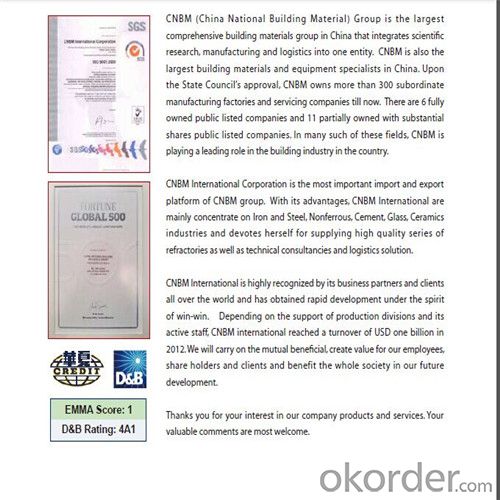

- Q:How do you determine the appropriate crucible capacity for a specific application?
- When determining the suitable crucible capacity for a particular application, several factors must be taken into consideration. Firstly, the quantity of material that needs to be melted or heated in the crucible should be evaluated. This can be determined by considering either the volume or weight of the material. It is essential to select a crucible size that can accommodate the material adequately, avoiding both overflow and being too empty. These situations can negatively impact the heating efficiency and the final product's quality. Secondly, the required melting or heating temperature for the specific application needs to be considered. Different materials have varying melting points, and some may necessitate higher temperatures than others. The crucible should have the capacity to withstand and maintain the desired temperature without experiencing cracking or deformation. Moreover, the duration of the application needs to be taken into account. If the application requires an extended period of melting or heating, it is crucial to choose a crucible size that can hold the material for the required duration, eliminating the need for frequent refilling or emptying. This ensures a continuous and efficient operation. Additionally, the type of crucible material plays a significant role in determining the appropriate capacity. Various materials have different thermal conductivity and compatibility with specific substances. It is imperative to select a crucible material that is suitable for the specific application to prevent contamination or reactions between the crucible and the material being heated. Lastly, it is advisable to consult the manufacturer or supplier of the crucible for their recommendations. They possess the expertise and knowledge to guide you in selecting the appropriate crucible capacity based on your specific application requirements. By considering these factors and seeking expert advice, the appropriate crucible capacity for your specific application can be determined, ensuring optimal performance and desired results.
- Q:What is graphite?
- Of the six Fang system with a complete lamellar cleavage. The cleavage surface is mainly based on molecular bonds, and has weaker molecular attraction, so its natural floatability is very good.
- Q:Are there any alternative materials to graphite for crucibles?
- Yes, there are alternative materials to graphite for crucibles. Some common alternatives include silicon carbide, alumina, zirconia, and boron nitride. These materials are often preferred for their specific properties and applications. For example, silicon carbide exhibits excellent thermal conductivity and high mechanical strength, making it suitable for high-temperature applications. Alumina, on the other hand, is known for its chemical inertness and resistance to corrosion, making it ideal for handling reactive materials. Zirconia offers good thermal shock resistance and is often used in applications requiring rapid temperature changes. Lastly, boron nitride is preferred for its excellent thermal stability and lubricity. Each of these alternative materials has its own advantages and specific uses, making them viable options for crucibles depending on the specific requirements of the application.
- Q:What are the uses of graphite? What are the downstream products of graphite?
- As refractory material: graphite and its products have the properties of high temperature resistance and high strength. They are mainly used in the metallurgical industry to make graphite crucibles. In the process of steelmaking, graphite is often used as a protective agent for steel ingots and lining of metallurgical furnaces
- Q:Why graphite and diamond is composed of carbon graphite, but not light, is black, and the diamond is urgently in light!
- Although they are all carbon, the arrangement of the carbon atoms is different, so different structures lead to different physical properties
- Q:How does the oxidation resistance of graphite affect the performance of a crucible?
- The oxidation resistance of graphite plays a crucial role in determining the performance of a crucible. Graphite is a commonly used material for crucibles due to its high melting point, thermal conductivity, and chemical inertness. However, graphite is susceptible to oxidation at high temperatures, which can significantly impact the performance of a crucible. Oxidation occurs when oxygen reacts with the carbon atoms in graphite, forming carbon dioxide (CO2) or carbon monoxide (CO) gas. This process leads to the degradation of the graphite structure, causing it to lose its desirable properties. As a result, the crucible may become weak, brittle, and develop cracks or holes, compromising its ability to contain and withstand high temperatures and corrosive environments. The oxidation resistance of graphite is therefore crucial in maintaining the integrity and longevity of a crucible. Graphite materials with higher oxidation resistance can withstand exposure to oxygen at elevated temperatures without significant degradation. They can resist the formation of CO2 or CO gas and retain their structural integrity, ensuring the crucible remains intact and capable of withstanding repeated heating and cooling cycles. A crucible with good oxidation resistance will have a longer lifespan, as it can endure high-temperature applications without significant wear or damage. It will also maintain its thermal conductivity, which is essential for efficient heat transfer and uniform temperature distribution during processes such as melting, casting, or chemical reactions. Furthermore, the oxidation resistance of graphite in a crucible affects the purity of the substances being processed. Oxidation can lead to the formation of impurities, such as carbon dioxide or carbon monoxide, which can contaminate the materials being held in the crucible. This can be particularly problematic in industries such as metallurgy or semiconductor manufacturing, where high purity is essential for the quality of the final product. In conclusion, the oxidation resistance of graphite greatly influences the performance of a crucible. A crucible made from graphite with high oxidation resistance will have a longer lifespan, maintain its structural integrity, and ensure the purity of the materials being processed. Thus, careful consideration of the oxidation resistance when selecting a crucible material is essential for optimal performance and cost-effectiveness in various industrial applications.
- Q:The biggest problem with graphite crucibles must be to use in a vacuum or a reducing atmosphere
- Reducing atmosphere is in such as crucible with coke and he is using a principle that because the air has been burning up!
- Q:How does the thermal conductivity of the molten metal affect the performance of a crucible?
- The thermal conductivity of the molten metal plays a crucial role in determining the performance of a crucible. The thermal conductivity refers to the ability of a material to conduct heat, and in the case of a crucible, it directly affects its ability to withstand and distribute high temperatures. A high thermal conductivity of the molten metal can lead to faster heat transfer from the crucible, resulting in a more uniform distribution of heat. This is beneficial as it allows for faster and more efficient melting or heating of the metal inside the crucible. It also helps in maintaining a consistent temperature throughout the crucible, which is important for certain industrial processes where precise temperature control is required. On the other hand, a low thermal conductivity of the molten metal can have negative implications on the performance of a crucible. It can lead to uneven distribution of heat, causing hot spots or cold spots within the crucible. This can result in uneven melting or heating of the metal, leading to poor quality or incomplete reactions in industrial processes. Additionally, the lack of efficient heat transfer can potentially lead to overheating of certain areas of the crucible, leading to premature failure or damage. In summary, the thermal conductivity of the molten metal directly affects the performance of a crucible. A high thermal conductivity allows for faster and more efficient heat transfer, resulting in better temperature control and more effective industrial processes. Conversely, a low thermal conductivity can lead to uneven heat distribution and potential damage to the crucible, compromising its performance.
- Q:Can a graphite crucible be used for nickel melting?
- Indeed, nickel melting can be accomplished using a graphite crucible. Graphite crucibles are frequently employed in situations involving elevated temperatures, such as the melting of metals like nickel. Graphite possesses a notable melting point, exceptional thermal conductivity, and commendable resistance to chemical corrosion, rendering it suitable for both melting and containing nickel. Moreover, graphite crucibles facilitate effective heat transfer, thereby enabling efficient and uniform melting of the metal. Nevertheless, it is crucial to verify that the graphite crucible is explicitly engineered for high-temperature applications and is compatible with the melting temperature of nickel to preclude any potential complications or harm.
- Q:Can graphite crucibles be used for heat treatment processes?
- Graphite crucibles are capable of being utilized in heat treatment procedures. Graphite possesses a high melting point and exceptional thermal conductivity, rendering it an optimal material for applications necessitating elevated temperatures and efficient heat transfer. Heat treatment processes entail the elevation of materials to specific temperatures in order to modify their physical or chemical properties. Graphite crucibles can endure these elevated temperatures without undergoing melting or deformation, guaranteeing the stability and integrity of the heat treatment procedure. Moreover, graphite's minimal reactivity with most substances renders it suitable for a broad range of heat treatment applications, encompassing annealing, tempering, quenching, and carburizing. In general, graphite crucibles prove to be a favored choice for heat treatment processes due to their resistance to high temperatures, thermal conductivity, and chemical inertness.
1. Manufacturer Overview |
|
|---|---|
| Location | |
| Year Established | |
| Annual Output Value | |
| Main Markets | |
| Company Certifications | |
2. Manufacturer Certificates |
|
|---|---|
| a) Certification Name | |
| Range | |
| Reference | |
| Validity Period | |
3. Manufacturer Capability |
|
|---|---|
| a)Trade Capacity | |
| Nearest Port | |
| Export Percentage | |
| No.of Employees in Trade Department | |
| Language Spoken: | |
| b)Factory Information | |
| Factory Size: | |
| No. of Production Lines | |
| Contract Manufacturing | |
| Product Price Range | |
Send your message to us
Sic Graphite Crucible
- Loading Port:
- Shanghai
- Payment Terms:
- TT OR LC
- Min Order Qty:
- 1 pc
- Supply Capability:
- 1000 pc/month
OKorder Service Pledge
OKorder Financial Service
Similar products
New products
Hot products
Related keywords
